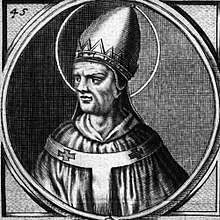Pope Sixtus III
Pope Saint Sixtus III | |
|---|---|
 | |
| Papacy began | 31 July 432 |
| Papacy ended | 28 March 440[1] |
| Predecessor | Celestine I |
| Successor | Leo I |
| Personal details | |
| Born | Sixtus |
| Died | 18 August 440 (aged 50) Rome, Western Roman Empire |
| Sainthood | |
| Feast day | 28 March |
| Other popes named Sixtus | |
| Papal styles of Pope Sixtus III | |
|---|---|
 | |
| Reference style | His Holiness |
| Spoken style | Your Holiness |
| Religious style | Holy Father |
| Posthumous style | Saint |
Pope Sixtus III (d. 18 August 440) was Pope from 31 July 432 to his death in 440. His ascension to the papacy is associated with a period of increased construction in the city of Rome. His feast day is celebrated by Catholics on March 28th.
Biography
Sixtus was born in Rome and before his accession he was prominent among the Roman clergy,[2] and frequently corresponded with Augustine of Hippo.[3]
Peter Brown says that prior to being made Pope, Sixtus was a patron of Pelagius, who was later condemned as a heretic,[4] although Butler disagrees and attributes the charge to Garnier.[1] Nicholas Weber also disputes this, "...it was probably owing to his conciliatory disposition that he was falsely accused of leanings towards these heresies."[2]
Sixtus was consecrated Pope on 31 July, 432. He attempted to restore peace between Cyril of Alexandria and John of Antioch. He also defended the rights of the Pope over Illyria and the position of the archbishop of Thessalonica as head of the local Illyrian church against the ambition of Proclus of Constantinople.[2]
His name is often connected with a great building boom in Rome: Santa Sabina on the Aventine Hill was dedicated during his pontificate. He built the Liberian Basilica as Santa Maria Maggiore, whose dedication to Mary the Mother of God reflected his acceptance of the Ecumenical council of Ephesus which closed in 431. At that council, the debate over Christ's human and divine natures turned on whether Mary could legitimately be called the "Mother of God" or only "Mother of Christ". The council gave her the Greek title Theotokos (literally "God-bearer", or "Mother of God"), and the dedication of the large church in Rome is a response to that.
His feast is kept on 28 March.[2]
See also
References
- ^ a b Butler, Alban. “Saint Sixtus III, Pope”. Lives of the Fathers, Martyrs, and Principal Saints, 1866. CatholicSaints.Info. 22 March 2013
- ^ a b c d Weber, Nicholas. "Pope St. Sixtus III." The Catholic Encyclopedia Vol. 14. New York: Robert Appleton Company, 1912. 15 September 2017
- ^ "St. Sixtus III, Pope", Catholic News Agency, March 28, 2017
- ^ Brown, Peter. "Pelagius and his Supporters." Journal of Theological Studies. 1968.XIX.1(93–114).
![]() This article incorporates text from a publication now in the public domain: Herbermann, Charles, ed. (1913). "Pope St. Sixtus III". Catholic Encyclopedia. New York: Robert Appleton Company.
This article incorporates text from a publication now in the public domain: Herbermann, Charles, ed. (1913). "Pope St. Sixtus III". Catholic Encyclopedia. New York: Robert Appleton Company.
Literature
- Helmut Feld (1995). "Sixtus III". In Bautz, Traugott (ed.). Biographisch-Bibliographisches Kirchenlexikon (BBKL) (in German). Vol. 10. Herzberg: Bautz. cols. 583–584. ISBN 3-88309-062-X.
External links
- Opera Omnia by Migne Patrologia Latina with analytical indexes
- "Pope Sixtus III" in the Ecumenical Lexicon of Saints
- Collected works by Migne Patrologia Latina
